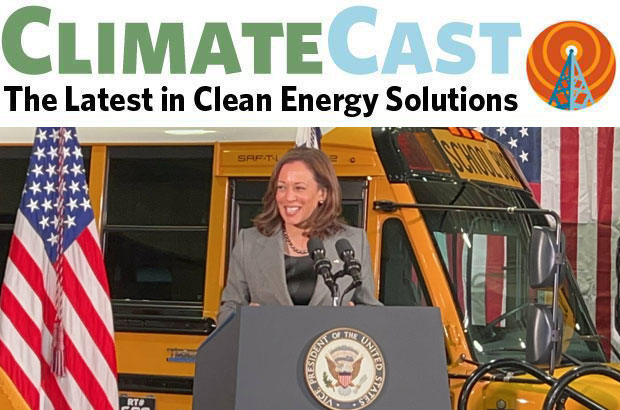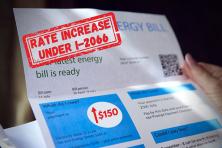This week, Democrats officially nominated Vice President Kamala Harris as the party’s candidate for president, prompting climate advocates to look at her record and commitments on climate and clean energy. As Vice President, Harris gets credit for the Biden administration’s substantial record of climate action, directly boosting efforts such as the push to deploy more electric school buses, which brought her to Seattle in 2022. At last year’s climate summit in Dubai, Harris issued an urgent call for action, saying that “the clock is no longer just ticking, it is banging.”
Earlier in her career, as a Senator and as California’s Attorney General, Harris had already established a record of support for progressive climate policies, including measures supporting environmental justice and clean energy development. However, she appears to have backed off from some climate positions she espoused as recently as five years ago when, as the Washington Post notes, she vowed to “immediately stop new oil leases on federal lands and waters. She endorsed a ban on fracking — which Biden did not — and proposed a $10 trillion plan to fight climate change, which she described as ‘an existential threat to us as a species.’”
Harris’ presidential campaign is only a few weeks old, and she has not committed herself to a detailed platform on climate, as on most other issues. Clean energy challenges ahead include grid infrastructure and slowing or stopping the expansion of gas extraction, among others. As Bill McKibben points out, a long primary season is often activists’ best opportunity to press candidates on these and other climate-related. Indeed, he writes, “that’s how climate became a real presidential issue for the first time in the 2020 race, which led directly to the Inflation Reduction Act.”
However, climate leaders like Washington Gov. Jay Inslee are not concerned about the Harris campaign’s lack of specific policy proposals on climate issues. Inslee told the New York Times: “I am totally confident that when she is in a position to effect positive change, she will.” When climate voters tick the presidential box on their ballots this fall, the most important question before them may simply be how Harris and Trump compare on climate change (spoiler: they don’t).
Two years in, the IRA is earning praise for supercharging clean energy in the US
The Inflation Reduction Act is being celebrated on its second anniversary from the coast of Maine to the coast of Oregon for the green energy transition projects and funding it has made possible. Oregon has locked in $285 million in funding so far, with more pending next year thanks in part to a wide variety of existing climate action programs. Nationwide, $8 billion has been claimed in tax credits by families updating their homes with insulation, windows, rooftop solar and heat pump installations.
The IRA has also proved to have outstanding benefits for labor, as Heatmap News explains: “in order to qualify for a 30% tax credit on their investment or operating costs, clean energy developers now have to follow key labor standards.” Specifically, the law raises pay for construction workers and pays for the education of apprentices at the same time. These labor standards should lead to 3.9 million good jobs across 6,285 clean energy projects. The IRA is single handedly undoing the damage of the North American Free Trade Agreement that sent many American jobs overseas. New battery and solar plants are launching throughout the Midwest.
A fiscal analysis of the law indicates that Republican-led states have benefited the most from the IRA: “Of all new projects, those in Republican districts represent 85% of the investments and 68% of jobs. Of the top 20 congressional districts for clean energy investments, 19 are held by Republicans.”
Quietly showcasing climate policy progress at work in Washington
Washington State’s flagship cap-and-invest program, the Climate Commitment Act, continues to quietly bring in steady, unprecedented revenue for the state’s climate, clean energy, and conservation programs. With almost two years of carbon allowance auctions complete (two more to be held in 2024), investment dollars are rolling out visibly across the state (see a full map of projects and investments in this new dashboard).
In its latest round of CCA-funded grantmaking this June, the Department of Commerce allocated more than $72 million in grants to local community organizations, businesses, and municipalities for renewable energy generation and storage. These grants are supporting solar installation in MFH and low-income homes in Spokane; on schools and colleges in Grays Harbor, and municipal buildings like the Twisp Civic Building. Earlier this spring, local headlines highlighted the $85 million for EV charging stations providing grants for nearly 5,000 EV chargers in 471 locations around the state.
What we’re listening to
La Climática Podcast is coming all the way from Spain! Here’s an opportunity to practice your Spanish while learning about the many ways folks are combating climate change around the world. Host Rocío Gómez covers a wide variety of topics on this new podcast, ranging from rewilding Spain’s rivers to increasing biodiversity and reducing emissions to the complex ecological, political and economic consequences of tourism in the Canary Islands.





